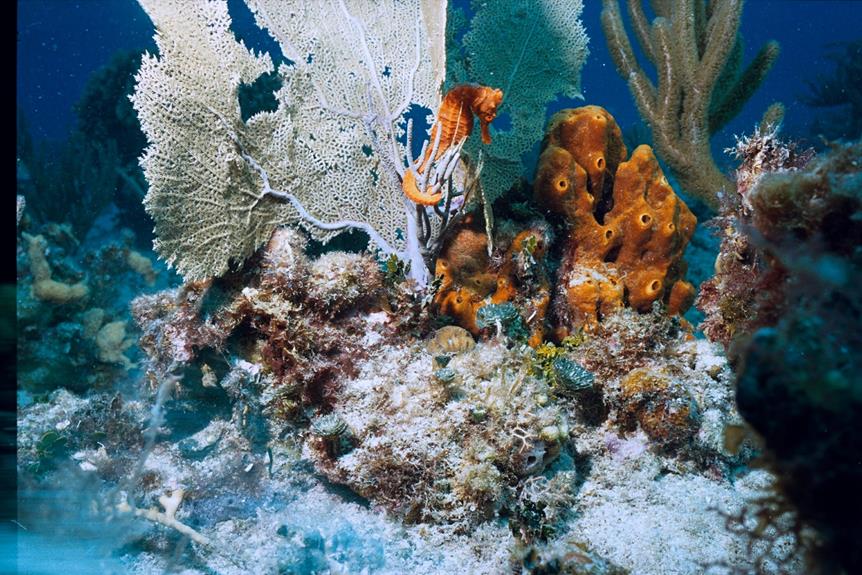Understanding the nuanced light requirements of Anubias plants is crucial for their sustained well-being within an aquarium environment.
From discerning the ideal light intensity to recognizing the specific needs of different Anubias varieties, a tailored approach to lighting can make a substantial difference in their growth trajectory.
As we navigate the intricacies of Anubias light preferences, we uncover a world where the interplay between light exposure and plant vitality is a delicate balance worth exploring further.
Stay tuned to unravel the essential insights that can help you optimize the lighting conditions for your Anubias plants, ensuring a flourishing aquatic ecosystem.
Key Takeaways
- Anubias thrive in low to medium light conditions, making bright light unnecessary for growth.
- Proper light exposure is crucial to keep Anubias healthy and avoid damage.
- Anubias require 8 to 9 hours of light daily to support their growth.
- Avoid direct sunlight exposure to prevent burning and maintain Anubias health.
Recommended Light Intensity for Anubias
The recommended light intensity for Anubias plants ranges between 1.5 to 3 watts per gallon, ensuring optimal growth and health for these aquatic species. When considering the light spectrum, Anubias generally thrive under low to medium light conditions, with bright light not being a necessity for their growth.
It is crucial to provide a light duration of 8 to 9 hours daily to meet their needs adequately. LED lights with adjustable brightness are ideal for achieving the recommended light levels without causing harm. Anubias are adaptable to different light conditions, but excessive light can lead to issues like algae growth, plant burn, and potential harm to fish.
Proper placement to avoid direct sunlight exposure is crucial for maintaining the health of Anubias plants.
Variability of Anubias Light Needs
Understanding the diverse light requirements among different Anubias species is essential for successfully cultivating these aquatic plants in varying aquarium environments. Anubias species exhibit variability in their light needs, with some requiring low to medium light, while others can thrive in low light conditions.
When considering light for Anubias, it is important to take into account the light spectrum and duration. Different species may have specific preferences for light spectrum, such as preferring LED lights with adjustable brightness. Additionally, the duration of light exposure is crucial, with most Anubias requiring 8 to 9 hours of light daily.
Impact of Light on Anubias Growth
When considering the impact of light on Anubias growth, it is crucial to recognize how varying light conditions can directly influence the development and overall health of these aquatic plants.
Light duration plays a significant role in the growth rate of Anubias, with an optimal range of 8 to 9 hours daily. Anubias exhibit a remarkable shade tolerance, making them suitable for low to medium light conditions.
The leaf color of Anubias can also be affected by the intensity and spectrum of light they receive. It is important to note that while bright light is not necessary for their growth, excessive light exposure can lead to issues such as algae growth and potential harm to the plants and fish in the aquarium.
Considerations for Anubias Light Sources
Considering the diverse lighting needs of Anubias species, selecting appropriate light sources is essential for maintaining their optimal growth and health in an aquarium setting. When choosing light sources for Anubias, it is crucial to consider factors such as light spectrum and lighting duration to ensure the plants receive the necessary light for photosynthesis and overall well-being. LED lights with adjustable brightness are commonly recommended for their energy efficiency and customizable settings. Anubias typically thrive in low to medium light conditions, making it important to avoid excessive brightness that can harm the plants. Providing a consistent lighting schedule of 8 to 9 hours daily can help Anubias achieve their full growth potential and contribute to a balanced aquarium ecosystem.
| Light Source | Light Spectrum | Lighting Duration |
|---|---|---|
| LED Lights | Full Spectrum | 8-9 hours/day |
| Fluorescent Lights | Cool White | 8-9 hours/day |
| T5/T8 Lights | Daylight Spectrum | 8-9 hours/day |
Effects of Light on Anubias Health
Light plays a crucial role in influencing the overall health and growth of Anubias plants within an aquarium environment. The duration of light exposure is essential as it impacts the resilience of Anubias. Providing the correct light spectrum is crucial for promoting efficient photosynthesis in Anubias plants.
Ensuring the right balance of light duration and spectrum can help maintain the health and vitality of Anubias in the aquarium. It is important to avoid excessive light exposure, as it can have detrimental effects on both the plants and the aquatic ecosystem.
Managing Light Exposure for Anubias
Effective management of light exposure is essential in ensuring the optimal health and growth of Anubias plants in an aquarium setting. Proper rhizome positioning and controlling light duration are crucial factors for maintaining these plants. Light intensity directly impacts the growth rate of Anubias; therefore, it is important to provide the appropriate amount of light to avoid stunted growth or algae overgrowth. Anubias typically thrive in low to medium light conditions, making it essential to find a balance to prevent damage. LED lights with adjustable brightness can help achieve the ideal light intensity for Anubias. Ensuring the right light exposure will promote healthy growth and prevent any negative effects on the plants.
| Rhizome Positioning | Light Duration | Light Intensity | Growth Rate |
|---|---|---|---|
| Proper placement to avoid damage | 8-9 hours daily | Adjust based on plant needs | Directly impacts growth |
Frequently Asked Questions
Can Anubias Survive in Low Light Conditions for an Extended Period of Time?
Anubias can survive in low light conditions for an extended period. While growth may be slower, the plants remain healthy. Monitoring for any signs of stress or lack of vitality is crucial to ensure the Anubias thrives under these light conditions.
Are There Any Specific Anubias Species That Require Higher Light Intensity Than Others?
While one might assume all Anubias species have uniform light needs, certain varieties like Anubias barteri var. nana 'Pinto' demand higher light intensity for optimal growth. Understanding individual Anubias species' light requirements is vital for thriving plants.
How Does Light Exposure Affect the Flowering of Anubias Plants?
Light exposure influences the flowering of Anubias plants by stimulating growth patterns under specific light intensities. Proper light levels trigger flowering, affecting bloom duration and frequency. Understanding these effects aids in optimizing Anubias plant health and reproduction.
Can Artificial Light Sources Be Used Exclusively for Growing Anubias, or Is Natural Light Necessary?
Artificial light sources like LED or fluorescent lighting can exclusively support Anubias growth, as natural light isn't mandatory. Understanding the light spectrum for growth is crucial. LED lights offer adjustable brightness, aiding in maintaining optimal conditions for Anubias.
What Are the Potential Consequences of Providing Too Much Light for Anubias Plants in an Aquarium Setting?
Overexposure to light can have detrimental consequences for Anubias in an aquarium, leading to plant stress, burn damage, and potential death. Anubias, known for thriving in low light conditions, require a delicate balance to ensure survival.
Conclusion
In conclusion, the intricate balance of light intensity and duration plays a critical role in the health and growth of Anubias plants. By carefully considering the specific light requirements of each variety and ensuring optimal exposure without causing harm, aquarists can cultivate thriving ecosystems within their tanks.
The interplay between light and plant vitality unveils a captivating journey of discovery and mastery in the realm of aquarium plant care. Explore the depths of Anubias light requirements to unlock the full potential of your aquatic flora.





